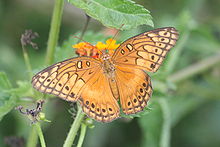- Euptoieta hegesia
-
Mexican Fritillary 
Scientific classification Kingdom: Animalia Phylum: Arthropoda Class: Insecta Order: Lepidoptera Family: Nymphalidae Genus: Euptoieta Species: E. hegesia Binomial name Euptoieta hegesia
(Cramer, 1779)The Mexican Fritillary (Euptoieta hegesia) is a North and South American butterfly in the family Nymphalidae.
Contents
Description
The upper side of the wings is bright orange with the basal part of the hind wing unmarked. There is a row of submarginal black spots on both the fore wing and the hind wing. The underside of the wings is yellow-orange with no submarginal black spots.[1] It has a wingspan of 2.5 to 3 inches.[2]
Similar Species
The only similar species in the Mexican Fritillary's range is the Variegated Fritillary (Euptoieta claudia). The Variegated Fritillary has black median lines on the upper side of the hind wing, and on the underside of the hind wing it has a pale postmedian band.[1]
Flight
The Mexican Fritillary may be seen from mid-June to November in Arizona, from July to December in Texas and year-round in Mexico.[2][3]
Habitat
This species may be encountered in a wide range of open habitats and gardens.[2]
Life cycle
The larva is shiny red, with middorsal silver spots edged with black. It has a subdorsal row of white spots ringed with black, a spiracular silver line with black edges, and six rows of black spines. The red head has two long black spines with clubbed ends. The chrysalis is dark brown or rarely tan, with gold eyes and short gold lateral and subdorsal cones. On the wing cases, it has a black marking shaped like a "T". It has 1-3 broods per year.[3]
Host Plants
Here is a list of host plants used by the Mexican Fritillary:
- Foetid Passionflower, Passiflora foetida
- Yellow Alder, Turnera ulmifolia (used in Mexico and in the Antilles)
- Ipomoea maritima (used in Brazil)[2][3]
References
- ^ a b Jim P. Brock and Kenn Kaufman (2003). Butterflies of North America. Houghton Mifflin, New York, NY. ISBN 0-618-15312-8
- ^ a b c d Bob Stewart, Priscilla Brodkin and Hank Brodkin (2001). Butterflies of Arizona. West Coast Lady Press, Arcata, CA. ISBN 0-9663072-1-6
- ^ a b c James A. Scott (1986). The Butterflies of North America. Stanford University Press, Stanford, CA. ISBN 0-8047-2013-4
Categories:- Butterflies and moths of North America
- Argynnini
Wikimedia Foundation. 2010.
